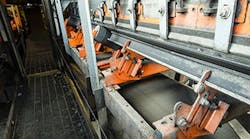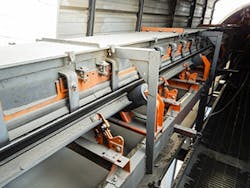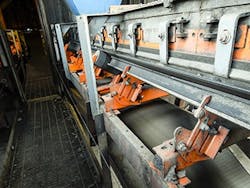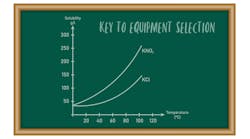Fertilizer Plant Tackles Belt Conveyor Issues
The Coffeyville Resources nitrogen fertilizer plant in Coffeyville, Kan., produced 814,700 tons of ammonia and 1,268,400 tons of urea ammonium nitrate (UAN) in 2017, enough to supply approximately 5% of total U.S. demand. It is one of just two such plants in North America that doesn’t rely on natural gas as an energy source — and the only one that uses petroleum coke (petcoke) gasification to provide the hydrogen essential for its operations. The facility’s location adjacent to a refinery gives it ready access to the large volumes of petcoke produced there. About 80% of the petcoke fuel required for production comes from the neighboring refinery.
Historically, petcoke has been significantly less expensive than natural gas on a per-ton-of-fertilizer-produced basis, and coke prices have been more stable than those of natural gas. By using petcoke as its primary energy source, the plant traditionally has been the lowest-cost producer of ammonia and UAN fertilizers in North America.
The Coffeyville operation moves most of the petcoke via conveyor; the plant maintains completely redundant systems to protect against unplanned shutdowns. The dual conveyor systems have run for many years without major failures but were beginning to show their age. In addition, the site wanted to improve material control and overall efficiency by taking advantage of advancements in conveyor technology since those systems were installed.
[callToAction]
One of the primary issues to address was material containment — reducing the amount of dust and spillage that escaped from the conveyors. After walking the entire length of two sets of twin conveyors, we identified conveyors 19A and 19B as being most in need of attention; each has a 24-in. wide belt, 300 ft long. Travelling at 400 ft/min, the belts carry an estimated 1,400 t/d of petcoke to an entrained flow gasifier. The twin belts have two load zones each; these were among the main points of concern.
The spillage was significant. Waist-deep piles were accumulating each day. An average of about 90 man-hours per week was necessary to safely clean the affected areas and haul the material away. In addition, cleaning and adjusting the belts, addressing worn components and keeping the system running required another 16 hours of maintenance time each week. Belts, rollers and other components were wearing out prematurely. Given the tab for replacement parts and labor, the opportunity for cost reductions looked good.
Based on site visits, technicians determined that the containment issues were primarily a result of carryback from insufficient belt cleaning and misalignment. The skirts and tail boxes were also allowing fugitive material to escape.
Stabilizing And Sealing
So, the plant launched a modernization project in 4th quarter of 2015. It included upgrading the transfer points to eliminate belt sag, provide effective sealing and improve belt cleaning, as well as alignment systems to deliver continuous adjustment and maintain a consistent belt path (Figure 1). Components used were specifically designed for durability under the heavy load and impact at the transfer points.
Figure 1. Upgrade eliminates belt sag and improves sealing, and includes belt cleaning and alignment systems.
Technicians first installed three impact cradles on both 19A and 19B, located under the belt in the loading zones (Figure 2). The cradle design features a bed of steel angles lined by energy-absorbing impact bars with a top layer of low-friction ultra-high-molecular-weight plastic. The impact beds absorb the energy, so the belt doesn’t have to. They also create a flat edge for the edge seal, to prevent spillage and fugitive dust. The cradles feature wing supports that adjust to match Conveyor Equipment Manufacturers Association standard trough angles, as well as provide a 5% fine tuning. This allows the cradles to accommodate the idler profiles of different manufacturers and ensure a tight belt seal.
After the impact zone, a series of 16 slider cradles were installed on each conveyor to stabilize the belt line and eliminate bounce. Transfer points can be prone to spillage as the load lands on the receiving conveyor. Once the belt leaves the impact cradle, it also can sag while the material is still settling. This compromises the skirt seal, allowing dust and fines to escape while creating entrapment points where material can get caught and gouge the belt.
The slider cradles are designed for conveyor systems with speeds up to 700 ft/min and belt lengths of more than 50 feet. Typically 48-in. long, the units also are available in custom sizes. The proprietary box design allows flipping each bar over at the end of its useful life to provide a second wear surface. The result is a flat and stable belt surface throughout the settling zone, reducing fugitive material and extending belt life.
Following the cradles, 20 Trac-Mount idlers were installed on each conveyor. These rugged idlers have sliding frames on a stationary base that fits in tight spaces between belt support cradles for easy installation and service. Supplied with either steel or impact rollers, they require only eight inches of space for the 6-in. rollers and can be serviced without raising the belt or removing adjacent rollers.
Dust Management
The system upgrade also included 90 feet of modular chute wall, which provides a system of compatible components to build a transfer chute and wall structure. The prefabricated components make it easy to design and install transfer-point skirtboards and stilling zones to manage air flow and control dust, keeping climatic conditions outside and airborne dust inside. The components simply bolt together to reduce installation labor, requiring no field engineering or material waste and providing a precise fit to suit the specific requirements of each conveyor load zone.
To further improve containment, 184 feet of Martin’s ApronSeal skirting system was installed. It offers dual-seal efficiency with a single one-piece sealing strip for any trough angle to prevent the escape of fines and dust. The unique design delivers two wear surfaces on a single elastomer sealing strip. When the bottom side of the strip against the belt is worn, inverting the sealing strip provides a second service life.
It’s the first dual-sealing system for belt conveyors, incorporating a primary seal clamped to the steel skirtboard to keep lumps on the belt and a secondary or “outrigger” strip to capture any fines or dust particles that pass beneath the primary seal. The secondary seal lies gently on the belt and self-adjusts to maintain consistent strip-to-belt pressure despite high-speed material movement and fluctuations in the belt’s line of travel. The skirting floats on the belt and self-adjusts to maintain an effective seal without maintenance.
Figure 2. Installed in the loading zones on each conveyor, these create a flat edge for improved containment.
Tackling Other Problems
To address belt mistracking, the installation includes a Martin Tracker system to deliver immediate precise adjustment of wandering belts. Rollers attached to the end of a sensing arm assembly ride both sides of the belt edge, detecting even slight variations in the belt path. Employing the force of the wandering belt, the arms automatically position a steering idler in the opposite direction of the misalignment. Transferring the motion to the steering idler through a unique parallel linkage requires less force to initiate the correction, enabling continuous, active and accurate finetuning of the path. The Tracker keeps the belt in alignment with automatic corrections to reduce edge damage, prevent spillage and maintain belt health.
Carryback can be a vexing problem for conveyor operators, especially when loads are heavy and materials contain moisture, which tends to cause fines to stick to the belt and get carried along the return run where vibration knocks the particles loose and deposits them on support structures, rollers and floors. To address this issue, technicians installed a dual cleaning system on the 19A and 19B conveyors. The primary unit is Martin’s QC1 Cleaner HD, a heavy-duty design with a one-piece curved urethane blade that delivers excellent performance. Its simple one-pin replacement without tools minimizes service time when the blade wears out. The design maintains cleaning performance through all stages of blade life. The unit can withstand corrosive conditions and service temperatures up to 180°F.
Mounted directly after the primary cleaner is a secondary scraper, the SQC2S cleaner; it features individually cushioned tungsten carbide blades for effective cleaning without risk to the belt or splices. Patented rubber buffers maintain the cleaning pressure throughout blade life while deflecting sufficiently to allow splices to pass without harm and ensuring compatibility with reversing belts or those that experience backup at shutdown.
The two-conveyor project took about a week for each belt, with six Martin Engineering installers on site. The team completed one upgrade while the other conveyor continued running, then switched over to the second structure.
Impressive Results
The upgrade has drastically reduced the amount of dust and spillage and, with it, the labor necessary to deal with the consequences. The total maintenance time to manage fugitive material on both conveyors now has fallen to about eight hours per week; what used to be a huge maintenance task now just involves occasional sweeping. Personnel spend less time working in close proximity to the moving conveyor, reducing potential risk. The plant likely is saving about $14,000 each month on labor previously required for the conveyor systems, and now is deploying staff to more productive activities. Moreover, belts and other components are showing no signs of premature wear; their longer service life should further increase the benefits achieved.
Plant management was so pleased with the results that they decided to upgrade another, shorter pair of conveyors. These two 15-ft feeder conveyors supply material to the upgraded conveyor systems. Both are 42-in. wide, running at 65 ft/min. They posed issues similar to those of the 19A and 19B conveyor systems. Martin technicians installed chute wall, idlers and skirt seal to contain dust and fines. To accompany the QC1 Cleaner HD on these systems, they put in a Durt Hawg DH2 secondary belt cleaner, an extremely durable design with steel-tipped blades for demanding conditions. As part of the settling zone modification, they also installed the EVO external wear liner along the edges of the chute wall; unlike traditional wear liners, the innovative design is mounted and serviced outside the chute wall, making it easy to inspect and replace without confined space entry.
The plant now is considering proposals to upgrade additional conveyors as well as future training and service agreements.
MARC GILBERTSON is operations technical superintendent at the Coffeyville Resources nitrogen fertilizer plant in Coffeyville, Kan. CORY GOLDBECK is territory manager for Martin Engineering, Neponset, Ill. Email them at [email protected] and [email protected].




